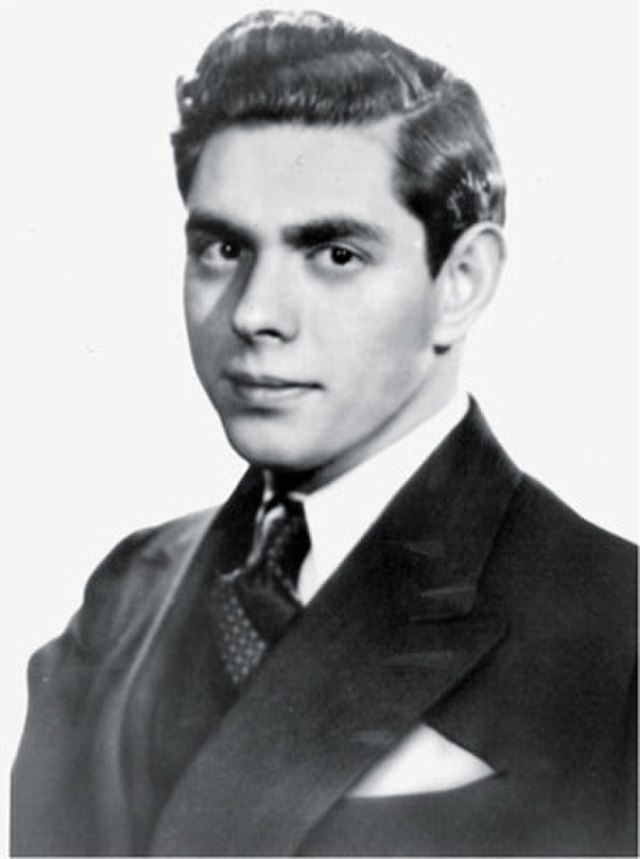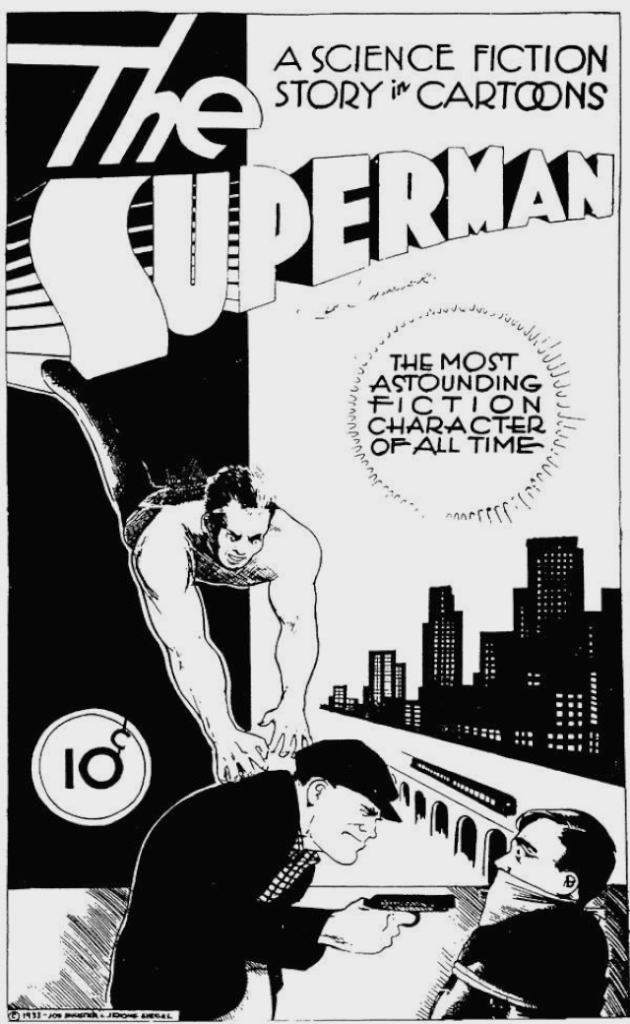November 24, 2023
Superman’s Real Life Father: Jerry Siegel

“Faster than a speeding bullet. More powerful than a locomotive. Able to leap tall buildings in a single bound.” If you grew up enjoying superheroes, chances are you have heard this famous phrase many times. It is often used as an introduction to the world’s very first superhero, Superman. But exactly who is responsible for the creation of such an iconic character?

Jerry Siegel (b. 1914), son of a Jewish immigrant who lived in Cleveland, Ohio, had one goal and one goal only: to become a comic book writer and earn a fortune just as many other comic book writers had done at the time. While Jerry already possessed wonderful writing skills from spending copious amounts of hours reading, he needed an artist to bring his vision to life. Luckily for him, his soon-to-be best friend, Joe Shuster, was a talented artist and happened to attend the same school, Glennville High.1 Thanks to their matching initials, Jerry Siegel and Joe Shuster were often seated together in school, as students were often alphabetized. By chance, both teens loved science fiction. Joe showed his drawings to Jerry while Jerry shared his writing with Joe. Years later, Jerry described meeting Joe as “the right chemicals coming together.”2
One night in 1932, while Jerry was reading fantasy magazines, his father, Michel, who was in his sixties, was managing a clothing store that he owned across town. Unbeknownst to Jerry, he would never see his father ever again. That night, just before closing, Michel was shot dead while apprehending a group of thieves. A reporter had delivered the news to the Siegel family later that night at a nearby hospital. The next day, the biggest local newspaper failed to mention the crime. Michel’s store was the primary source of income for the Siegel family. Being in the midst of the Great Depression, to Jerry, it seemed like the world had come to an end.3
Despite the horrific tragedy, Jerry had to move on with his life. Just a few months after his father’s passing, Jerry turned on the radio and began listening to a recently-become popular show called Tarzan of the Apes. Jerry was instantly hooked. He was already familiar with Tarzan from comics in the newspapers and the books written by Edgar Rice Burroughs. In the third episode of the series, Tarzan was referred to as a “superman.” Jerry had become fond of another book by Burroughs, A Princess of Mars. Jerry was fascinated by the main character, John Carter, who visits the planet Mars, where he is able to jump thirty feet up in the air thanks to Mars’ gravity. In essence, he became a superpowered alien. These stories inspired Jerry, as he would eventually apply aspects of them into his Superman mythos.4
Before touching the comic book genre, Jerry had written a short story for the magazine Science Fiction. Rather than the panel-by-panel story-telling of comic books, the story was presented in paragraphs accompanied by several featured pieces of artwork. After Joe had completed his drawings, Jerry then took over, copying his script onto the pages around Joe’s drawings. When the final product was complete, the front page featured an evil-looking bald man staring down upon a city. Above the artwork was the title, “The Reign of the Super-Man.” Superman was not yet a character who stood for moral righteousness but instead was one of evil and terror. Additionally, Superman’s abilities did not consist of super strength or flying, but of mind control.5 While the story may not have sold well, it was a great first start for Jerry.6

With “The Reign of the Super-Man” not selling well, Jerry knew he had to rethink his concept of what a Superman was. One summer night after Jerry’s high school graduation, he couldn’t sleep. So many new ideas kept coming to him in a frenzy. The biggest idea out of the bunch was of a man using his superpowers as a force for good as opposed to evil.7 Before writing for Superman again, however, it was time for Jerry to begin writing actual comics instead of magazine prints.
Jerry had come up with the idea to write stories for what he called Popular Comics, which would be composed of both adventure and comedy stories. Jerry and Joe pitched Popular Comics to The Cleveland Shopping News, a local news press, and to both of their surprise, it was approved. Jerry celebrated with his best friend by going over to the movie theater for a double feature. Unfortunately, The Cleveland Shopping News changed their minds, meaning Jerry was back to square one. Jerry continued to send his work to various publishers, to either be rejected or to receive no response at all. Eventually, Jerry organized a meeting with a publisher from Humor Publications to present an old idea of his, titled “The Superman.”8

A copy of “The Superman” for the project was completed, but it never made it to the public. While we don’t know what really happened, it is said that Jerry had considered dropping Joe as his artist, and in retaliation, Joe burned the only copy of “The Superman,” and it never got presented to Humor Publications. In an attempt to save his work, Jerry had only managed to save the cover, which featured a shirtless man leaping towards an armed mugger, aiming a gun at a gagged man. The legitimacy of this cover remains a mystery, as the date appears to read 1928, long before Jerry and Joe had met, and a copyright symbol is visible at the bottom right of the page, even though no copyright had been made yet.9 Despite the major setback, Jerry and Joe made up and returned to work.10
After losing his work from “The Superman,” Jerry continued to brainstorm ideas on how to improve his character. He knew he had a great idea; he just needed to make a few more improvements. Jerry had watched circus performers ever since he was a child. The costumes they wore during the shows inspired the red boots and underwear used in the final costume for Superman. Jerry also enjoyed Swashbuckler movies, where long flowing capes were fashionable—another feature worn by the famous superhero. Over time, Jerry finally conjured up a perfected iteration of his Superman.11
By the year 1937, numerous publishers had already heard of Superman through all the proposals Jerry had mailed out. All were hesitant to publish his idea—all but one. On January 10, 1938, Jerry received a letter from an editor by the name of Vin Sullivan. Sullivan liked Jerry’s idea and asked if thirteen pages could be featured in their next comic lineup. While it is unknown what happened immediately afterward, Jerry received additional letters directing him to send his Superman story to Detective Comics, later abbreviated to DC Comics. Then, on March 3, 1938, Jerry sold the rights to Superman over to Detective Comics. Finally, his time to make a fortune was here. Unfortunately, that was not the case. The rights to Superman were sold for roughly one hundred thirty dollars.12 It was too late by the time Jerry realized his mistake. He no longer had any legal claim to the character he spent all those years conjuring up. Jerry implored for the rights back, but saw no luck. Shortly after signing off the rights to Superman, the magazine Action Comics #1 was released. The cover, featuring Superman lifting a car above his head while spectators flee the scene in horror, instantly grabbed the attention of young readers and has since become the most iconic image of all comic books. After the release of Action Comics, Jerry’s publisher allowed him to continue writing for the character. Although it may seem like a victory, Jerry’s publisher received all the profits made from sales, while Jerry only received minimal pay.13
Jerry Siegel spent his whole life reading science fiction stories and always dreamed of making a fortune off his own writings. Alas, while his greatest creation was flying off the newsstands, the riches generated from Superman sales were not his to keep.
- Salem Press Biographical Encyclopedia, 2023, s.v. “Jerry Siegel,” by Michael Adams. ↵
- Brad Ricca, Super Boys (New York: St. Martin’s Press, 2013), 41. ↵
- Brad Ricca, Super Boys (New York: St. Martin’s Press,2013), 4-7. ↵
- Brad Ricca, Super Boys (New York: St. Martin’s Press,2013), 43-44. ↵
- Brad Ricca, Super Boys (New York: St. Martin’s Press,2013), 65-71. ↵
- The Guardian, 1996, s.v. “Flight of Fantasy: Obituary of Jerry Siegel,” by Paul Gravett. ↵
- Robert Mcg. Thomas Jr., “Jerry Siegel, Superman’s Creator, Dies at 81,” The New York Times, 1996. ↵
- Brad Ricca, Super Boys (New York: St. Martin’s Press,2013), 84-89. ↵
- Brad Ricca, Super Boys (New York: St. Martin’s Press,2013), 97-99. ↵
- Brad Ricca, Super Boys (New York: St. Martin’s Press,2013), 102. ↵
- Brad Ricca, Super Boys (New York: St. Martin’s Press,2013), 128-130. ↵
- Brad Ricca, Super Boys (New York: St. Martin’s Press,2013), 145-150. ↵
- Brad Ricca, Super Boys (New York: St. Martin’s Press,2013), 155-156. ↵
Tags from the story
Comics
Jerry Siegel
Joe Shuster
Superman